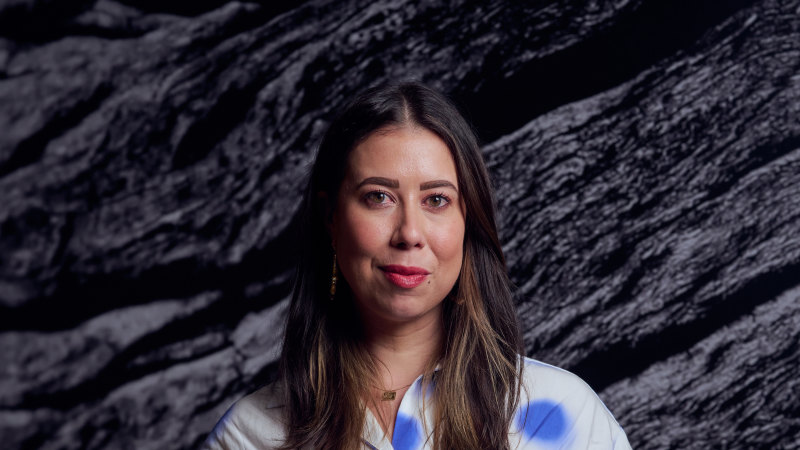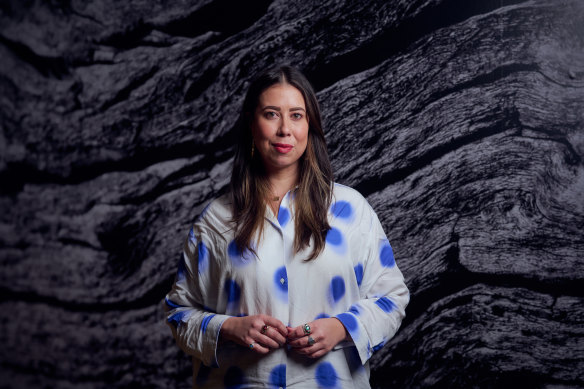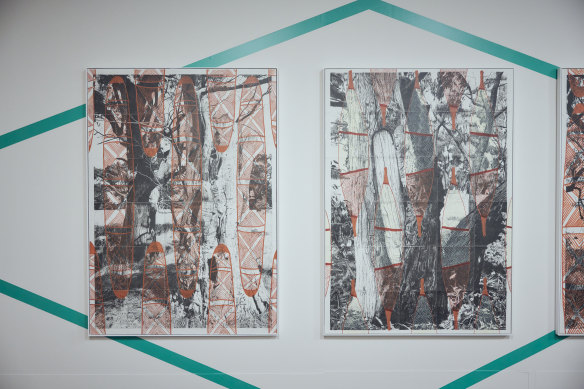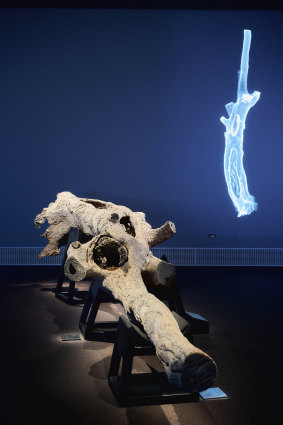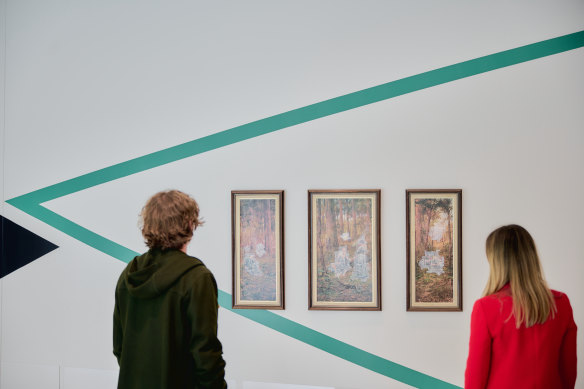Save articles for later
Add articles to your saved list and come back to them any time.
The trees stand in bushland and stock paddocks around the state, passed by thousands of unaware commuters every day.
Some are recorded, occasionally venerated, though many more remain inconspicuous – keepers of a once threatened (and challenging) cultural knowledge.
Kimberley Moulton sees wooden items in Museums Victoria’s collection as extensions of Country.Credit: Eugene Hyland
Culturally marked trees, also known as scar trees, have been modified in some way – usually by the removal of sections of bark – to create a tool or in some cases to communicate information, like directions, and special and sacred areas to First Peoples.
“My favourite thing to do is drive around looking out for them. When you actually start to open your eyes to them, you see scars everywhere,” says Yorta Yorta woman, Kimberley Moulton.
“You can only imagine how many more would have been in our landscape, and how many exist now within museum spaces.”
As curator of southeastern Aboriginal collections at Museums Victoria, Moulton regularly wanders the aisles of vast storage facilities containing shelves and cabinet drawers crammed full of artefacts that have come to be known, institutionally, as collections of Indigenous cultural objects.
Within those collections are the scarred limbs of trees and wooden objects like canoes, shields and coolamons, but Moulton considers these items to be much more than simply objects – instead viewing them as extensions of Country and living “ancestral belongings”.
“You see the hand of the maker, you see the care and time they’ve put into these things, whether it be a shield or a necklace or an emu feather skirt, the bodies that would have worn them, the dances and ceremonies they would have been part of,” Moulton says.
While connecting with these belongings is culturally enriching for Moulton, the mass collections are also imbued with the legacy of violent colonial history, a conflict Moulton says she reckons with every day as an Aboriginal person working within a state cultural institution.
In More Than a Tarrang (Tree), Moulton and several co-curators interrogate these tensions between the cultural agency of First Peoples, their Country and kin, memory, and the history of mass collection of cultural materials – both internationally and domestically.
More Than a Tarrang (Tree) includes new artworks from senior and emerging artists alike.Credit: Eugene Hyland
The multilayered project is a collaboration between the museum and the Wominjeka Djeembana Indigenous research lab at Monash University and includes the curation of Professor Brian Martin, a Bundjalung, Muruwari and Kamilaroi man, Professor Brook Andrew (Wiradjuri -Ngunnawal), and Dr Jessica Neath.
It features 25 cultural belongings from Victoria and New South Wales, with some among the earliest in the collection – circa 1840 – and many of which have never been displayed before.
The marks upon the Yalukit Weelam Tarrang show how bark was removed to create coolamons and shields.Credit: Eugene Hyland
The centrepiece is the Yalukit Weelam Tarrang, a marked eucalypt tree salvaged from the Werribee river plain on Boon Wurrung Country in 2020.
At a length of around five metres, it’s gnarled and weathered body is reposed, as though lying-in-state, at the gallery’s inner sanctum. The marks upon it show how bark was removed to create coolamons and shields, belongings which over history largely comprised the mass collections of colonial cultural institutions.
“With much of the early First Peoples collections, the Country where they are from, the maker, their story and cultural narratives were unrecorded by collectors and [that] speaks to the early colonial practice of dislocating cultural belongings from people and their systems of knowledge,” Moulton says.
The exhibition also includes new artworks from senior and emerging artists, including Martin, Andrew, N’Arweet Carolyn Briggs, Moorina Bonini, Maya Hodge, Brad Webb, Uncle Greg Griffiths, Uncle Alfred Priestley, Simon Rose and Deep Design Lab.
Two pieces by Bonini located in the main foyer gallery outside the Bunjilaka collection are particularly striking. An installation of disused wooden museum boxes arranged on a ring of orange sand once held significant south-eastern Indigenous cultural material in the museum’s collection across the 1950s, 1960s and 1970s.
The artist re-appropriates the containers with burnt patterning across their surfaces informed by traditional mark making on ancestral belongings.
The exhibition showcases 25 cultural belongings from Victoria and NSW.Credit: Eugene Hyland
Another provocative work reconstructs the triptych painting of The Pioneer by Australian artist Frederick McCubbin — a painting that memorialises settler colonialism — by erasing the subjects’ presence with mark-making informed by the pattern designs of southeastern First Peoples.
Also providing a jolt for viewers is Martin’s finely detailed representations of marked and patterned living trees in situ displayed behind dismembered marked limbs that lay austerely on museum storage pallets.
“I’m really interested in that space of what and how contemporary Indigenous art practice and making, and its relationship to museum collections, can be a form of restitution to community,” Moulton says.
Visitors look at Found (2018) by Morrina Bonini.Credit: Eugene Hyland
“It’s about building relationships … repatriating collections back to communities. To connect to these belongings strengthens us culturally, but it also strengthens the object and re-spirits, or re-narrates a story for these things that otherwise sit in the holding pattern of colonial history and time.”
More Than a Tarrang (tree): Memory, Material and Cultural Agency is at Bunjilaka Aboriginal Cultural Centre, Melbourne Museum, until November 5.
The Morning Edition newsletter is our guide to the day’s most important and interesting stories, analysis and insights. Sign up here.
Most Viewed in National
From our partners
Source: Read Full Article
